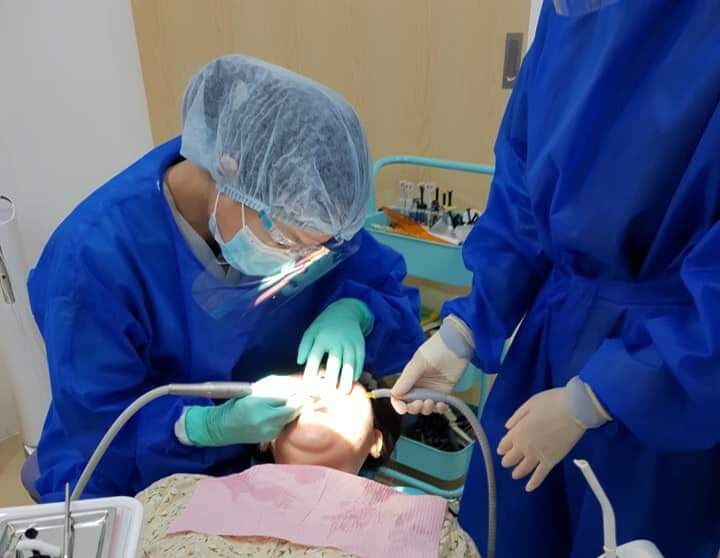The Benefits of Orthodontic Treatment
If your teeth are crowded, you might naturally want to hide your smile. However, are you aware of the numerous advantages that come with teeth straightening? Here are just a few reasons why you should consider getting orthodontic treatment:
1. Straight teeth are easier to maintain oral hygiene. This helps to reduce the risk of tooth decay and gum disease.
2. Correct teeth alignment improves your dental occlusion. Crooked teeth can cause problems when biting or chewing, which might result in digestive issues.
3. Aligned teeth have the potential to impart a more youthful look and boost your sense of youthfulness. A pleasantly straight smile can noticeably reduce years from your overall appearance.
4. Straight teeth can impart a youthful appearance and enhance self-confidence. Crooked teeth have a higher likelihood of sustaining damage or requiring additional dental interventions in the future.
If you’re considering orthodontic treatment, talk to your dentist about the best option for you. There are many different types of braces available, and they’re not all that noticeable anymore. Therefore, do not allow misaligned teeth to hinder you from attaining your most radiant smile!
Types of Braces and How to Choose the Right One
Numerous dental braces types are available for teeth straightening, and the most suitable one for you hinges on various factors.. In this blog, we will discuss the different types of braces and how to choose the right one for you.
Ceramic Brackets

Ceramic braces consist of a clear or white material. Less noticeable than their metal counterparts, ceramic alternatives find favor among adults and teenagers seeking smile enhancement..
While ceramic brackets have many benefits, they also have some drawbacks. One is that they are more fragile than metal braces and can break more easily. Furthermore, they can quickly develop stains, requiring you to exercise caution in your dietary and beverage selections while using them.
Traditional Metal Brackets

If you’re considering traditional metal braces for yourself or your child, you’re probably wondering what they are and how they work. In short, these are a type of orthodontic treatment that uses brackets and wires to straighten and moves the teeth.
Traditional metal braces include metal brackets bonded to the front of each tooth using bonding agent. The brackets thread the archwire and fasten it with small rubber bands, known as ligatures. This wire applies gentle pressure to the teeth, gradually shifting them into their desired position.
Metal braces are very strong and durable, which is why they’re such a popular choice for orthodontic treatment. They find application in addressing an array of dental issues, encompassing overcrowding, spacing, bite alignment, and more.
Another benefit of metal braces is that they’re very affordable. They’re usually much less expensive than other types of orthodontic treatment, such as ceramic or Invisalign. Their exceptional strength and durability mean that replacements are less frequent, resulting in potential long-term cost savings.
Metal braces have drawbacks: they’re noticeable when smiling, can cause discomfort by rubbing against gums, and may complicate eating certain foods.
Overall, metal braces are a great option for straightening your teeth. They’re strong, durable, and affordable, and they can correct even the most severe dental problems. Just keep in mind that they’re not very discreet and they can sometimes be uncomfortable. If these factors aren’t a concern for you, metal braces could be a suitable option!
Lingual Braces

If you are considering invisible braces, then lingual braces may be the solution for you. Placing lingual brackets on the backside of your teeth conceals them entirely from sight.
Although lingual braces offer discreet treatment, it’s crucial to note that they demand additional care and attention. Be sure to brush and floss thoroughly to avoid any problems with your teeth or gums.
Self-Ligating Braces

Type of orthodontic treatment, eliminate the need for elastic ties or bands to secure the archwire. These employ a distinct bracket with an integrated mechanism to hold the wire. They’re becoming popular with increased comfort, less gum irritation, and better aesthetics without visible ligatures seen in traditional braces.
Invisalign®

Considering Invisalign® for aligning your teeth? You’re in good company. Many choose these nearly invisible aligners over metal brackets. They’re easy to remove, allowing unrestricted eating, brushing, and flossing.
But how does Invisalign® work? It starts with a consultation with a skilled Invisalign® orthodontist or dentist. They’ll take x-rays, photos, and teeth impressions to create a precise 3D model. Using this model, your orthodontist will tailor a treatment plan specifically for you.
Once your treatment plan is in place, orthodontists will fashion custom-made aligners to suit your individual needs. You’ll need to wear each aligner for about one weeks before moving on to the next one in the series. As you move from aligner to aligner, your teeth will gradually shift into place. Before long, you’ll be enjoying the straight, healthy, and beautiful smile you’ve always desired!
When To Seek Orthodontic Treatment
If you’re thinking about orthodontic treatment for yourself or your child, you might be wondering about the optimal timing. While orthodontic treatment is beneficial at any age, there are specific periods when wearing braces could be particularly advantageous. Here are a few things to consider when deciding when to seek treatment.
If your child’s baby teeth are starting to come in crooked or crowded, it’s probably time to start thinking about it. Early treatment can help prevent more serious problems from developing later on. The American Association of Orthodontists recommends that children have an orthodontic evaluation by age 7.
If you’re an adult considering braces, there’s no need to worry that it’s too late. Many adults benefit from orthodontic treatment and it’s never too late to improve your smile. In fact, about one in five orthodontic patients is over the age of 18.
The severity of your problem will also play a role in deciding when to seek orthodontic treatment. If your misalignment is mild, you may not need braces at all. In cases of more severe misalignment, braces may be the best option.
The Cost of Braces
Braces are one of the most common things that people think of when they think of orthodontic treatment. They are also one of the most popular methods of achieving straighter teeth. But how much do braces cost? The answer may surprise you!
The cost of braces can differ due to various factors, such as the type of braces, the severity of the condition, and the duration of the treatment. However, on average, braces can cost anywhere from RM4,500 to RM20,000.
Consulting with an orthodontist will give you the most accurate estimate of the cost. Straight teeth are not only easier to keep clean, but they can also help to improve your overall oral health.
If you or your child are considering braces, consulting an orthodontist will provide the most accurate cost estimate.. They can evaluate your specific circumstances and provide a more precise insight into the expected treatment expenses.



